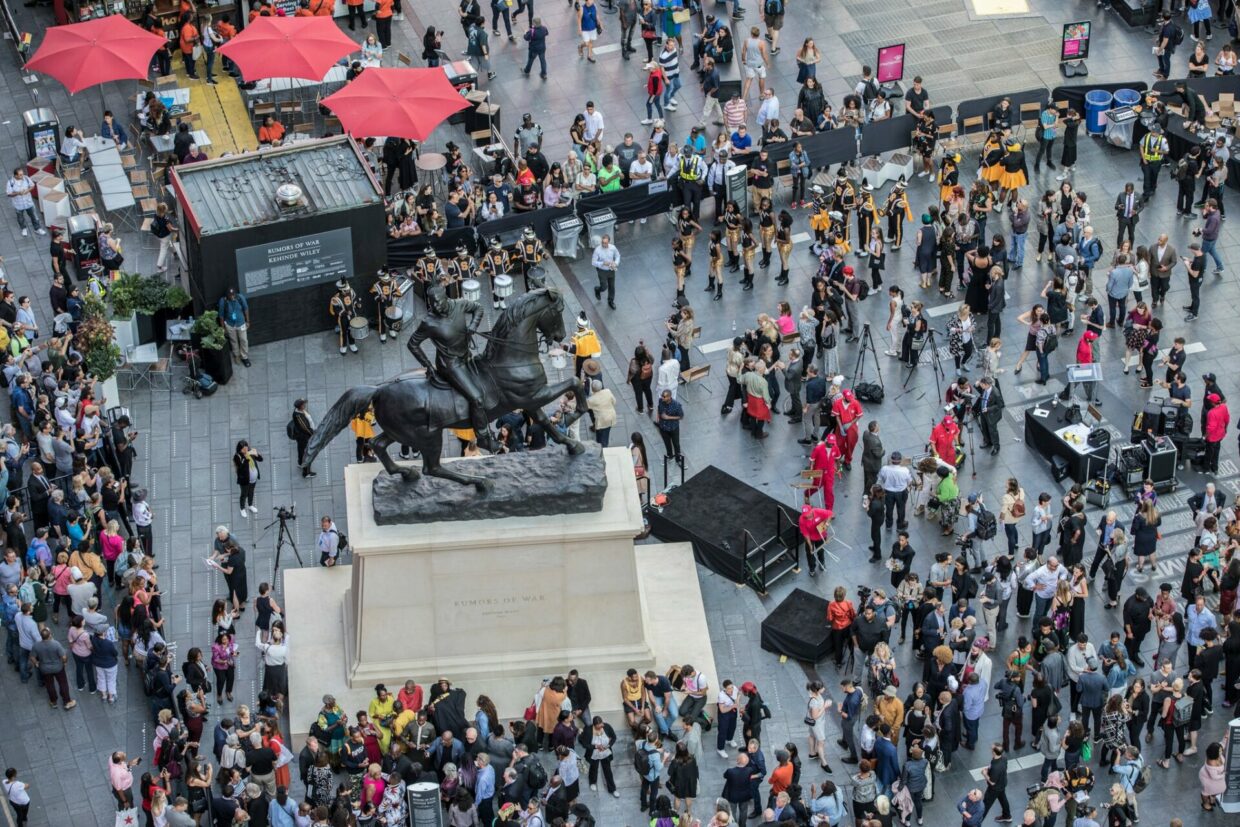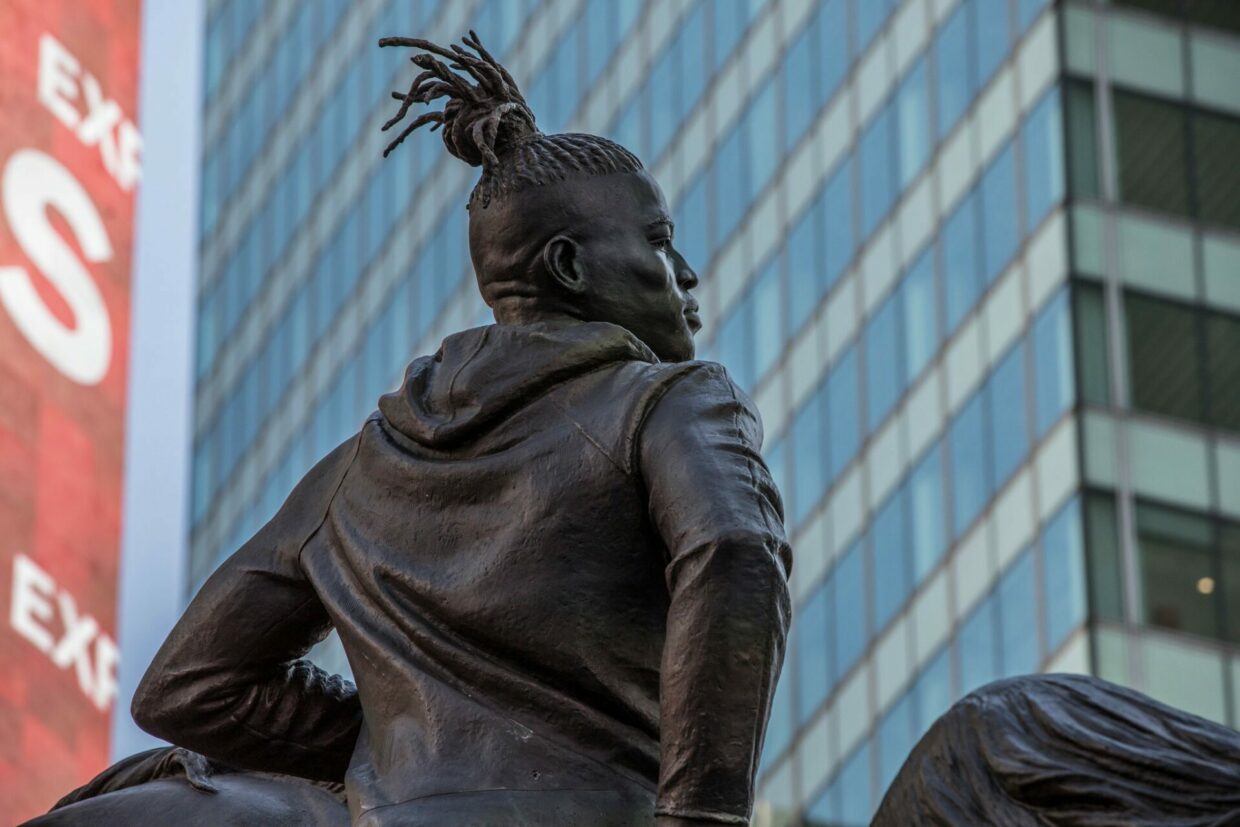Kehinde Wiley’s Times Square Monument: That’s No Robert E. Lee
Oct. 1, 2019
By:
He looks like a man lost in time, uprooted, with the horse he rode in on, from a previous century, perhaps, or was it a future one?
In a riot of flashing neon signs and costumed avengers, populating a patch of Times Square on Broadway between 46th and 47th Streets, he can be seen looking regal and triumphant astride a rearing steed worthy of Napoleon, flanked between the modern colonial outposts of American Eagle Outfitters and Express.
The new statue, a bronze sculpture on limestone titled “Rumors of War” and unveiled on Friday, is the first public work by the artist Kehinde Wiley. Mr. Wiley, 42, is best known for his aristocratic portraits of African-American men, including the one of President Obama that hangs in the National Portrait Gallery.
“Rumors of War,” Mr. Wiley’s largest sculpture to date at a towering 27 feet high and 16 feet wide, was inspired by the heroic, equestrian statues of Confederate generals in Richmond, Va., that line its famous Monument Avenue. After the sculpture leaves Times Square in December, it will be permanently installed in Richmond on Arthur Ashe Boulevard, a major thoroughfare, recently renamed after the Richmond-born African-American tennis icon, that crosses Monument Avenue.
The street’s renaming came amid a statewide reckoning over the Confederacy’s racist heritage. And the rider in “Rumors of War,” a young African-American man with a knot of dreadlocks in a hoodie and ripped jeans, reflects a similar effort to reclaim history.
“I felt that there had to be some way to turn this ship around,” Mr. Wiley said in an interview. “Maybe I can’t do it as one person, but this is my way of intervening, of saying ‘Enough already.’”
In Richmond, “Rumors of War” will stand near the entrance to the Virginia Museum of Fine Arts, just a few blocks south of its Confederate inspiration. But Mr. Wiley, a longtime resident of New York City whose work first gained notice at the Studio Museum in Harlem, wanted to premiere it close to home.
He found support from Times Square Arts, the public art program of the Times Square Alliance, in partnership with the Virginia museum and his longtime gallerist Sean Kelly.
“I think people come to Times Square with the readiness and expectation to see anything and everything,” said Jean Cooney, the director of Times Square Arts. “But even within that context, this will have a very striking presence.”
Mr. Wiley first conceived of the sculpture while visiting the Virginia museum for the opening of his exhibition “Kehinde Wiley: A New Republic” in June 2016. He was struck in particular by a statue of General J.E.B. Stuart and its evocation of Lost Cause ideology, which holds that the Confederate states were the noble targets of Northern aggression.
“I’m a black man walking those streets,” he said at the unveiling on Friday, recalling his visit to Richmond. “I’m looking up at those things that give me a sense of dread and fear.”
“Today,” he said, “we say yes to something that looks like us. We say yes to inclusivity. We say yes to broader notions of what it means to be an American.”
In 2017, after white nationalists in Charlottesville, Va. — protesting the planned removal of a Robert E. Lee statue there — ignited a deadly melee that sent shock waves throughout the country, Mr. Wiley redoubled his commitment to what became “Rumors of War.”
“The oppression of African-Americans is still pervasive in our society,” said Alex Nyerges, the director of the Virginia museum. “But if anyone is going to take on the mantle of trying to change the conversation and make things better for the present and the future, I can think of no better place to start.”
At the unveiling in Times Square Friday, as a marching band from the Malcolm X. Shabazz High School in Newark played in celebration, onlookers snapped cellphone photos and took in the district’s newest resident.
“You just don’t ever come across sculptures like this in the States,” said Gerry Atumeyi, who is from Nigeria and lives in the Bronx. “To see someone from the African-American community who is able to do that is really inspiring.”
Source: New York Times



